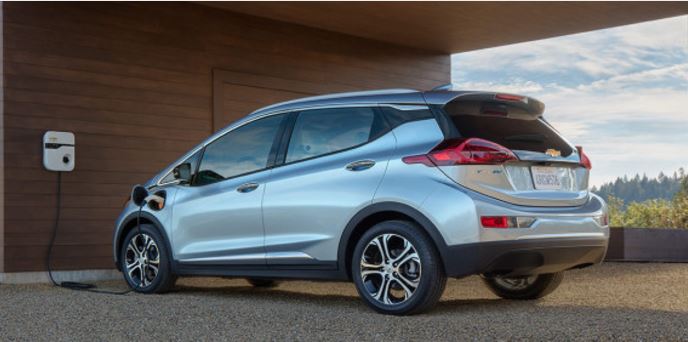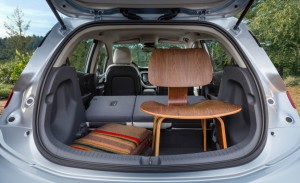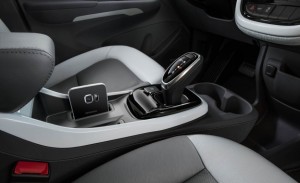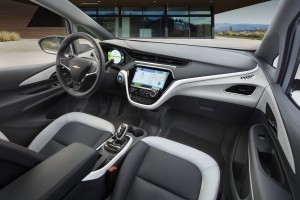News
Will the 200 mi, $30k Chevy Bolt challenge Tesla’s Model 3?
The Chevy Bolt and Tesla Model 3 will be priced nearly the same and will have about the same range. Is there room enough in the market for both or will one dominate the other in sales?
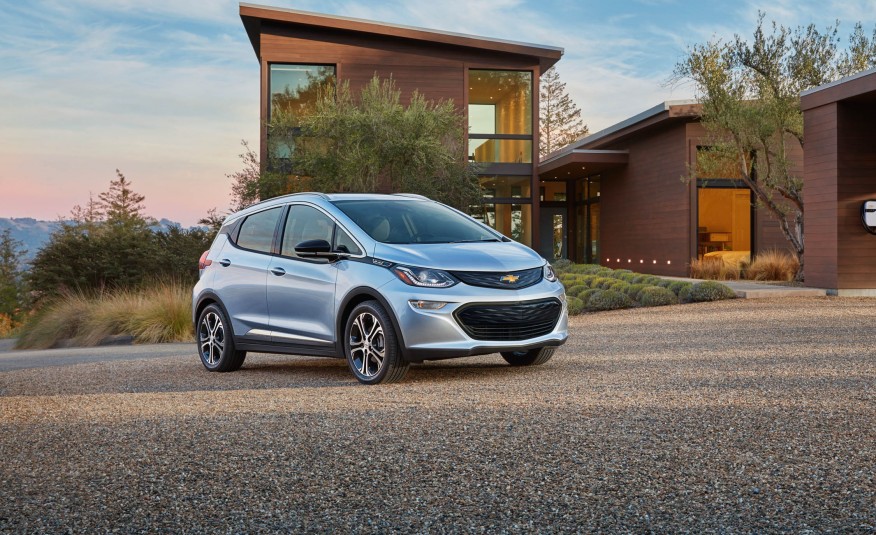
Chevrolet unveiled its production all electric Bolt at the Consumer Electronics Show (CES) this week. Promising a range of 200 miles on a single charge, and at a price point in the $30,000 range, the Chevy Bolt has many wondering how this will stack up against Tesla’s upcoming mass market Model 3, to be unveiled in March.
Price and Range
Both cars will be similarly priced. Tesla says the Model 3 will start at $35,000. Mary Barra, GM’s CEO said at CES on Wednesday the Bolt will start at $37,500 before incentives and rebates. Though she didn’t give any details about trim levels and options, we know that a fully equipped Chevy Volt costs about $8,000 more than the base model. Add the same amount to the Bolt and you have a retail price just north of $45,000.
In all likelihood, Tesla will offer a number of options on the Model 3 including a choice of battery sizes, single or dual motors, and possibly falcon wing doors as hinted by Elon Musk. It wouldn’t take much to get the price of a Model 3 above $45,000. We wouldn’t be surprised if a fully loaded Model 3 nudges the $60,000 mark.
Styling

Beauty is in the eye of the beholder, which couldn’t hold more true when it comes to the looks of the Chevy Bolt. Some have said it resembles a BMW i3 in the front and a Honda Fit in the rear. Despite the compact look of the Bolt, it’s quite roomy inside. The front seats are a monopost design similar to what Tesla uses for the second row seats in the Model X. The center console floats between the seat, leaving lots of foot room for rear seat passengers. The Bolt’s flat floor means it’s easy to slide in and out. It also has slightly more cargo room than the Honda Fit.
- Roomy Chevy Bolt storage capacity
No one knows yet what the Model 3 will look like, but Tesla has done an excellent job designing its cars so far. The Model S still looks modern even though it has been on the road for 4 years. We hear reports that Elon is pushing his engineers to get the coefficient of drag on the Model 3 below .20, which may require some extreme exterior designs. From what we know, the Model 3 will be larger than the Bolt, but is expected to be a sedan, at least initially. The Bolt is more of a crossover utility vehicle.
Connectivity and Autonomous Driving
Tesla has an enormous lead over other manufacturer thanks to its Autopilot software that shares what it knows with other Teslas via the cloud. It also has one of the user interfaces in the business. The touchscreen in the Bolt is adequate but not groundbreaking. The area where the Bolt and the Model 3 may be direct competitors is in the market for on-demand car sharing.

Ms. Barra announced the Bolt will have app based software that will make it suitable for car sharing. The corollary is that General Motors just invested a half billion dollars in Lyft. It clearly is positioning itself for the new transportation paradigm in which people don’t own cars anymore. They simple request the kind of car they need when they need it and pay the appropriate fee. Particularly for people in crowded urban areas, that model makes perfect economic sense.
But Tesla has its eye on that market as well. Who can forget Elon’s awkward moment during a recent conference call when analyst Adam Jonas asked him if Tesla was interested in pursing on-demand car sharing? Musk’s demeanor made it clear that Jonas’ question had hit a nerve. That’s where the collision between the Chevy Bolt and the Tesla Model 3 may occur, as both attempt to exploit new market opportunities.
Timing
Mary Barra confirmed Wednesday that Chevy Bolt production will begin late in 2016. That should give it about a one year head start in the market on the Tesla Model 3 — assuming Tesla keeps to its stated timeline. If it does, it will be the first time in company history. If it is delayed, it may spot the Bolt such a massive lead that it will never be able to catch up.
Elon Musk has challenged other automakers to make more and better electric cars. The Chevy Bolt is GM’s first attempt to rise to the challenge. Whether it is a Tesla killer or just a pretender won’t be known until at least a year from now.

Elon Musk
Elon Musk’s X will start using a Tesla-like software update strategy
The initiative seems designed to accelerate updates to the social media platform, while maintaining maximum transparency.

Elon Musk’s social media platform X will adopt a Tesla-esque approach to software updates for its algorithm.
The initiative seems designed to accelerate updates to the social media platform, while maintaining maximum transparency.
X’s updates to its updates
As per Musk in a post on X, the social media company will be making a new algorithm to determine what organic and advertising posts are recommended to users. These updates would then be repeated every four weeks.
“We will make the new 𝕏 algorithm, including all code used to determine what organic and advertising posts are recommended to users, open source in 7 days. This will be repeated every 4 weeks, with comprehensive developer notes, to help you understand what changed,” Musk wrote in his post.
The initiative somewhat mirrors Tesla’s over-the-air update model, where vehicle software is regularly refined and pushed to users with detailed release notes. This should allow users to better understand the details of X’s every update and foster a healthy feedback loop for the social media platform.
xAI and X
X, formerly Twitter, has been acquired by Elon Musk’s artificial intelligence startup, xAI last year. Since then, xAI has seen a rapid rise in valuation. Following the company’s the company’s upsized $20 billion Series E funding round, estimates now suggest that xAI is worth tens about $230 to $235 billion. That’s several times larger than Tesla when Elon Musk received his controversial 2018 CEO Performance Award.
As per xAI, the Series E funding round attracted a diverse group of investors, including Valor Equity Partners, Stepstone Group, Fidelity Management & Research Company, Qatar Investment Authority, MGX, and Baron Capital Group, among others. Strategic partners NVIDIA and Cisco Investments also continued support for building the world’s largest GPU clusters.
News
Tesla FSD Supervised wins MotorTrend’s Best Driver Assistance Award
The decision marks a notable reversal for the publication from prior years, with judges citing major real-world improvements that pushed Tesla’s latest FSD software ahead of every competing ADAS system.

Tesla’s Full Self-Driving (Supervised) system has been named the best driver-assistance technology on the market, earning top honors at the 2026 MotorTrend Best Tech Awards.
The decision marks a notable reversal for the publication from prior years, with judges citing major real-world improvements that pushed Tesla’s latest FSD software ahead of every competing ADAS system. And it wasn’t even close.
MotorTrend reverses course
MotorTrend awarded Tesla FSD (Supervised) its 2026 Best Tech Driver Assistance title after extensive testing of the latest v14 software. The publication acknowledged that it had previously criticized earlier versions of FSD for erratic behavior and near-miss incidents, ultimately favoring rivals such as GM’s Super Cruise in earlier evaluations.
According to MotorTrend, the newest iteration of FSD resolved many of those shortcomings. Testers said v14 showed far smoother behavior in complex urban scenarios, including unprotected left turns, traffic circles, emergency vehicles, and dense city streets. While the system still requires constant driver supervision, judges concluded that no other advanced driver-assistance system currently matches its breadth of capability.
Unlike rival systems that rely on combinations of cameras, radar, lidar, and mapped highways, Tesla’s FSD operates using a camera-only approach and is capable of driving on city streets, rural roads, and freeways. MotorTrend stated that pure utility, the ability to handle nearly all road types, ultimately separated FSD from competitors like Ford BlueCruise, GM Super Cruise, and BMW’s Highway Assistant.
High cost and high capability
MotorTrend also addressed FSD’s pricing, which remains significantly higher than rival systems. Tesla currently charges $8,000 for a one-time purchase or $99 per month for a subscription, compared with far lower upfront and subscription costs from other automakers. The publication noted that the premium is justified given FSD’s unmatched scope and continuous software evolution.
Safety remained a central focus of the evaluation. While testers reported collision-free operation over thousands of miles, they noted ongoing concerns around FSD’s configurable driving modes, including options that allow aggressive driving and speeds beyond posted limits. MotorTrend emphasized that, like all Level 2 systems, FSD still depends on a fully attentive human driver at all times.
Despite those caveats, the publication concluded that Tesla’s rapid software progress fundamentally reshaped the competitive landscape. For drivers seeking the most capable hands-on driver-assistance system available today, MotorTrend concluded Tesla FSD (Supervised) now stands alone at the top.
News
Elon Musk’s Grokipedia surges to 5.6M articles, almost 79% of English Wikipedia
The explosive growth marks a major milestone for the AI-powered online encyclopedia, which was launched by Elon Musk’s xAI just months ago.

Elon Musk’s Grokipedia has grown to an impressive 5,615,201 articles as of today, closing in on 79% of the English Wikipedia’s current total of 7,119,376 articles.
The explosive growth marks a major milestone for the AI-powered online encyclopedia, which was launched by Elon Musk’s xAI just months ago. Needless to say, it would only be a matter of time before Grokipedia exceeds English Wikipedia in sheer volume.
Grokipedia’s rapid growth
xAI’s vision for Grokipedia emphasizes neutrality, while Grok’s reasoning capabilities allow for fast drafting and fact-checking. When Elon Musk announced the initiative in late September 2025, he noted that Grokipedia would be an improvement to Wikipedia because it would be designed to avoid bias.
At the time, Musk noted that Grokipedia “is a necessary step towards the xAI goal of understanding the Universe.”
Grokipedia was launched in late October, and while xAI was careful to list it only as Version 0.1 at the time, the online encyclopedia immediately earned praise. Wikipedia co-founder Larry Sanger highlighted the project’s innovative approach, noting how it leverages AI to fill knowledge gaps and enable rapid updates. Netizens also observed how Grokipedia tends to present articles in a more objective manner compared to Wikipedia, which is edited by humans.
Elon Musk’s ambitious plans
With 5,615,201 total articles, Grokipedia has now grown to almost 79% of English Wikipedia’s article base. This is incredibly quick, though Grokipedia remains text-only for now. xAI, for its part, has now updated the online encyclopedia’s iteration to v0.2.
Elon Musk has shared bold ideas for Grokipedia, including sending a record of the entire knowledge base to space as part of xAI’s mission to preserve and expand human understanding. At some point, Musk stated that Grokipedia will be renamed to Encyclopedia Galactica, and it will be sent to the cosmos.
“When Grokipedia is good enough (long way to go), we will change the name to Encyclopedia Galactica. It will be an open source distillation of all knowledge, including audio, images and video. Join xAI to help build the sci-fi version of the Library of Alexandria!” Musk wrote, adding in a later post that “Copies will be etched in stone and sent to the Moon, Mars and beyond. This time, it will not be lost.”
